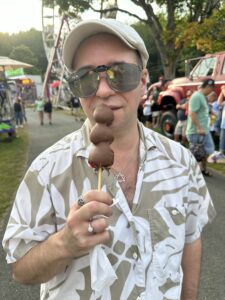It’s June–that month when we shove our lifestyle down your throat. You know you want it, baby.
Via the novelist Robert Jones, Jr.’s Substack, I discovered another Black queer radical newsletter, ToussaintF12’s notes from the edge of empire. His latest post, “queer as in ‘rocket launchertttt'”, is a snappy and well-researched battle cry for the current resistance. It’s worth reading in full, but here’s a highlight:
…empire, liberalism, and corporate agendas flatten all forms of deviance into marketable identities. specifically, a distinction between “gay” as an imperfect umbrella term and “queer”, as a term that alot of people still draw a false equivalence with. gay usually refers narrowly to sexual orientation, while queer functions more as a political orientation: a refusal of normativity in all its forms: gender, family, citizenship, economy, whiteness, nation-state, even time itself.
the difference matters because we live in a world where u can be gay and uphold carceral logic, imperial war, and racial capitalism. queer, signals something deeper than who u fuck or love. it signals how u resist. it pushes us to interrogate what we’re aligning with and what we’re opposing. without making that distinction, we risk reducing queerness to aesthetics, visibility, or lifestyle, and stripped of its insurrectionary potential.
the empire has learned to neutralize queerness by flattening it into mere identity. being gay is not a choice. it’s a biologically-influenced orientation shaped by complex interactions of genetics, hormones, and development. but queerness is not the same tho. queerness is a political decision, a social posture, a structural antagonism. it names a refusal to comply with the systems that manage and discipline sexuality and gender. to be queer, as in radical as fuck.
queerness is a mode of war against the social, political, and hegemonic order. it’s the art of becoming ungovernable while keeping love intact.
I found the above to be an enlightening framing for the dynamic between choice and innate identity with respect to my own transition. Because I’d already stepped (or been pushed) outside certain systems of normalcy, I was able to recognize who I wanted to be, and had some practice with putting my existing attachments at risk in order to thrive.
Speaking of Robert Jones, he is a very well-dressed man. His essay on the Met exhibit “Superfine: Tailoring Black Style” is a delight.
While it’s not often the focus of mainstream conversations, dandyism, as an identity, is a precursor to queerness; and many of the Black men (and others) who embraced the style were not just making fashion statements, but sociopolitical ones as well. They were attempting to break free of the patriarchal expectations regarding gender, gender expression, race, and sexuality that were (and are) forced upon Black men.
And they did so with enormous sartorial flair! Oh the drama, honey! The draaamaaa!
Also linked in Jones’ article, check out playwright Jeremy O. Harris’ Vogue essay “On Being a Modern Dandy,” archived here. Harris’ works include Slave Play.
A dandy, at his or her core, is a rewriter of narratives—the narratives carved into a society’s understanding about the communities from which the dandy has emerged.
…to be a Black dandy is to dress as though you know you’re loved and therefore have no use for shame. Shame is the enemy of all exuberance. Shame comes from fear, and fear is the enemy of style.
In an interview by Stephen Meisel at CRAFT Literary, poet and prose author Jesse Lee Kercheval discusses the mechanics of visual storytelling in her first graphic memoir, French Girl. I read a lot of graphic narratives, both for pleasure and for the Winning Writers self-published book contest (still open through July 1! send us your comix!). Something I’ve noticed is that text and image can wind up battling for dominance. Especially in nonfiction, the words may take over the page, reducing the visual element to static illustrations that leave me wondering why the memoir or exposition was put into a comics format at all. Conversely, an image-heavy story may lack verbal connective tissue to explain plot and setting. Kercheval talks about leading with the image so that it actually adds new emotional information to the text.
Most of the pieces in French Girl did begin with drawing rather than writing. After so many years as a writer, if I start with words, I end up with way too many words for a comic. And if I write first, then draw, I end up drawing the very thing I write… The idea is for the words and images to be different, for each to add something new to the whole.
…you can’t just say “apple” and draw an apple. Unless you are doing a children’s alphabet book. Something in the art has to fill in the scene, the character, the mood. Add what is not in the words. And the art needs to do a lot of work because the hardest thing for me with comics is how very few words you get.
In Electric Lit’s personal narratives column, Michelle Gurule makes a heartfelt case that “My Uncle Doesn’t Need to Die in Prison to Learn His Lesson”. Gurule humanizes her aging uncle before revealing more details that would lead some to deem his crime unforgivable, an effective rhetorical move that reminded me of Sister Helen Prejean’s philosophy that a person is more than the worst thing he’s ever done. Whatever we conclude about his worthiness for medical parole, we can’t see him as anything but a fully rounded human being, forever altered by decisions he made as a traumatized and impoverished 19-year-old.
The Guardian has a name for why I’m feeling crazy: “hypernormalization,” a Soviet-era term for dissociating about the collapse of society so that we can function in daily life.
For many in the US, Trump 2.0 is having a devastating effect on daily life. For others, the routines of life continue, albeit threaded with mind-altering horrors: scrolling past an AI-generated cartoon of Ice officers arresting immigrants before dinner, or hearing about starving Palestinian families while on a school run.
Hypernormalization captures this juxtaposition of the dysfunctional and mundane.
It’s “the visceral sense of waking up in an alternate timeline with a deep, bodily knowing that something isn’t right – but having no clear idea how to fix it”, [digital anthropologist Rahaf] Harfoush tells me. “It’s reading an article about childhood hunger and genocide, only to scroll down to a carefree listicle highlighting the best-dressed celebrities or a whimsical quiz about: ‘What Pop-Tart are you?’”
Hat tip to Charis Books & More, a feminist bookstore in Georgia, for the link. Donate to their fundraiser.
You know the meme.
In honor of Father’s Day this month, a couple of literary links. Hayan Charara’s poem “Translation” in Jewish Currents cleverly uses line breaks to bring out layers of meaning from an immigrant father’s misspoken idiom.
Get the get out of here my father
said to men and women he wanted
gone from his world By his world
I mean the beer and wine he built
and ran in Detroit And by beer and wine
I mean the convenience store he wanted
to call Father & Son but went with
Beer & Wine which is also
the prison he made for himself…
Winner of the Palette Poetry 2024-25 Previously Published Poem Prize, Ollie Schminkey’s “My Father” is an exceptionally successful contrapuntal. I’m never sure whether to read these two-column poems across, like lines with a large break in the middle, or down, like a newspaper. When they’re written properly, as here, they work in both directions. The form is perfect for this poem about losing his father to cancer. The father is both absent and present in the speaker’s mind, like an optical illusion flipping back and forth.
Another cancer poem, sorry, but this one is beautiful too: Geoff White’s “To a Friend Who Does Not Believe in God,” at Frontier Poetry. Similar in its use of duality as a formal device, the poem repeats variations on “And I did. And I didn’t.” to express the contradictory demands of witnessing a friend’s death. One cannot do anything to stop it, perhaps one cannot consistently have faith, yet one must do something to acknowledge and be present with this awful/awe-full passing.
…They said she was still listening though I didn’t
remember the last time
I saw her awake. And I didn’t
Then I did. Then I didn’t
Then that wasn’t the point anymore.
In response to RFK Jr.’s eugenicist statements, Illinois has taken steps to shield autistic people’s medical records, Noah Berlatsky reported last month for Prism.
Illinois Gov. JB Pritzker has signed an executive order safeguarding the medical records of autistic people in Illinois. The order follows a recent federal proposal by the National Institutes of Health (NIH) and the Department of Health and Human Services (HHS) to create a national autism database. It prevents state agencies from sharing autism-related information with anyone outside of state government without a clear reason and informed consent.
The order also clearly states that “autism is a neurological difference—not a disease or an epidemic—identified by trained clinicians and healthcare professionals, with rising identification rates attributable to improved practices, greater awareness, and expanded access to screening tools.”
Support Noah’s freelance journalism on Patreon.





